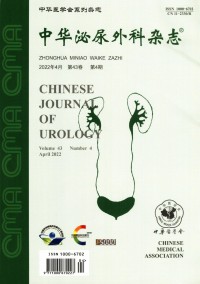The value of detection of circulating tumor cells in predicting lymph node metastasis of urothelial carcinoma
Q4 Medicine
引用次数: 0
Abstract
Objective To discuss the application experience and predictive value of circulating tumor cells for urothelial carcinoma. Methods The clinical data of 96 patients with urothelial carcinoma treated by Beijing Cancer Hospital Urologic Department between September 2017 and September 2019 were analyzed retrospectively to evaluate relationship between the number of CTCs and pathological outcome. The mean age of the entire cohort was 62(40-87)years, with 74 males and 22 females. There were 13 cases of upper urinary tract tumors (pyelocarcinoma and ureteral carcinoma), 83 cases of bladder carcinoma, and 12 cases of lymph node metastasis. There were 77 cases of primary onset and 19 cases of recurrence. 68 cases in single focus group and 28 cases in multiple group. There were 29 cases in non infiltrative Ta stage, 42 cases in infiltrative lamina propria T1 stage, 16 cases in infiltrative muscle T2 stage, and 9 cases in extra-muscular≥T3 stage. At least 3ml of peripheral blood was collected after fasting for at least 8 hours, After cleavage and centrifugation, immunomagnetic beads were added, folate probe was added, and then amplification was carried out. Then the copy number of CTCs in each ml of blood was calculated. Logistic linear regression was used to analyze the risk factors of lymph node metastasis. Results The mean CNC of all patients was 12.3±7.3; the mean CNC of ≤62 years old group was 10.8±4.2; the mean CNC of >62 years old group was 13.7±9.2; the mean CNC of initial cases was 11.5±5.3; the mean CNC of recurrent cases was 15.5±12.2. Age (P=0.135) and frequency of onset (P=0.087) had no effect on the number of CTCs. The average CNC of single focus group was 10.5±5.2, multiple focus group was 16.5±9.7, Ta stage group was 8.2±2.3, T1 stage group was 12.0±4.4, T2 stage group was 16.4±6.8, and ≥T3 stage group was 19.5±16.6. The number of lesions (P<0.001) was significantly correlated with pathological T stage (P<0.001) and the number of CTCs. Univariate regression analysis showed that T stage (P<0.001) and the number of CTCs (P=0.02) might be correlated with lymph node metastasis; multivariate analysis showed that only T stage could be used as an independent predictor of lymph node metastasis (P=0.002). Conclusions CTCs can be used to predict lymph node metastasis of urothelial carcinoma. Key words: Carcinoma, transitional cell; Urothelial carcinoma; Bladder cancer; Circulating tumor cells (CTCs); Lymph node metastasis; Risk factor循环肿瘤细胞检测在预测尿路上皮癌淋巴结转移中的价值
目的探讨循环肿瘤细胞在尿路上皮癌诊断中的应用经验及预测价值。方法回顾性分析2017年9月至2019年9月北京肿瘤医院泌尿外科收治的96例尿路上皮癌患者的临床资料,评价CTCs数量与病理转归的关系。整个队列的平均年龄为62岁(40-87岁),其中男性74人,女性22人。上尿路肿瘤(肾盂癌、输尿管癌)13例,膀胱癌83例,淋巴结转移12例。原发77例,复发19例。单焦点组68例,多焦点组28例。非浸润性Ta期29例,浸润性固有层T1期42例,浸润性肌T2期16例,肌外≥T3期9例。禁食至少8小时后采集外周血至少3ml,卵裂离心后,加入免疫磁珠,加入叶酸探针,进行扩增。然后计算每ml血液中ctc的拷贝数。采用Logistic线性回归分析淋巴结转移的危险因素。结果所有患者的平均CNC为12.3±7.3;≤62岁组平均CNC为10.8±4.2;62岁组平均CNC为13.7±9.2;初始病例的平均CNC为11.5±5.3;复发患者的平均CNC为15.5±12.2。年龄(P=0.135)和发病频率(P=0.087)对CTCs数量无影响。单灶组的平均CNC为10.5±5.2,多灶组的平均CNC为16.5±9.7,Ta期组的平均CNC为8.2±2.3,T1期组的平均CNC为12.0±4.4,T2期组的平均CNC为16.4±6.8,≥T3期组的平均CNC为19.5±16.6。病变数量(P<0.001)与病理T分期(P<0.001)和CTCs数量显著相关。单因素回归分析显示,T分期(P<0.001)和CTCs数量(P=0.02)可能与淋巴结转移相关;多因素分析显示,只有T期可以作为淋巴结转移的独立预测因子(P=0.002)。结论CTCs可用于预测尿路上皮癌的淋巴结转移。关键词:癌;移行细胞;移行细胞癌;膀胱癌;循环肿瘤细胞(ctc);淋巴结转移;风险因素
本文章由计算机程序翻译,如有差异,请以英文原文为准。
求助全文
约1分钟内获得全文
求助全文
来源期刊

中华泌尿外科杂志
Medicine-Nephrology
CiteScore
0.10
自引率
0.00%
发文量
14180
期刊介绍:
Chinese Journal of Urology (monthly) was founded in 1980. It is a publicly issued academic journal supervised by the China Association for Science and Technology and sponsored by the Chinese Medical Association. It mainly publishes original research papers, reviews and comments in this field. This journal mainly reports on the latest scientific research results and clinical diagnosis and treatment experience in the professional field of urology at home and abroad, as well as basic theoretical research results closely related to clinical practice.
The journal has columns such as treatises, abstracts of treatises, experimental studies, case reports, experience exchanges, reviews, reviews, lectures, etc.
Chinese Journal of Urology has been included in well-known databases such as Peking University Journal (Chinese Journal of Humanities and Social Sciences), CSCD Chinese Science Citation Database Source Journal (including extended version), and also included in American Chemical Abstracts (CA). The journal has been rated as a quality journal by the Association for Science and Technology and as an excellent journal by the Chinese Medical Association.
 求助内容:
求助内容: 应助结果提醒方式:
应助结果提醒方式:


